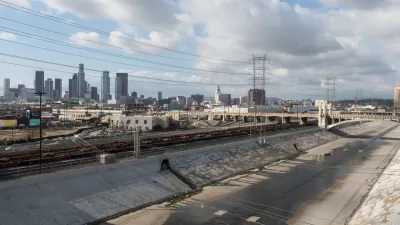Two and a half years after California shuttered its redevelopment agencies, cities are still grappling with the repercussions—from resolving the legal obligations of CRAs to searching for alternative methods of revitalizing areas in need.
To get a read on these efforts, The Planning Report spoke with Tim McOsker, a partner at Glaser Weil LLP who serves on a three-member governing board responsible for winding down Los Angeles’ Community Redevelopment Agency (CRA).
McOsker updates readers on Los Angeles' process following CRA dissolution in 2012 through today, commenting on the amount of tax dollars returned to local government and the city's relationship with the California Department of Finance. He also considers the future of tax-increment financing and other options for cities looking to promote economic development.
Here, McOsker explains the creation of long-range property management plans following the passage of AB 1484: "When the dissolution took effect, the LA CRA was holding about 400 parcels of property, which amounts to approximately 100 different projects—because some projects have multiple parcels. The first version of the dissolution law was interpreted to require entities like ours to wind down affairs and sell all of the properties as quickly as possible. Statewide, that would entail a lot of sales of former CRA lands all at once. Urban centers like Los Angeles saw the prospect of so many properties being up for sale at the same time—raising the specter of diminishing the values of properties and creating what some folks described as 'chaos.' Subsequently, AB 1484 slowed down the process and allowed each agency to put together a 'long range property management plan'... AB 1484 gave everybody an opportunity to plan for sales in a more orderly manner and over a longer period of time. It is very likely that the plans might protect the property values and not put urban-core areas with lots of parcels, like the City of Los Angeles, in limbo."
The Planning Report has published three other pieces in its series on TIF, which can be found here, here, and here.
FULL STORY: CRA Dissolution Process: A City of LA Status Report

Planetizen Federal Action Tracker
A weekly monitor of how Trump’s orders and actions are impacting planners and planning in America.

Maui's Vacation Rental Debate Turns Ugly
Verbal attacks, misinformation campaigns and fistfights plague a high-stakes debate to convert thousands of vacation rentals into long-term housing.

Cuomo Is the Candidate of Both NIMBYs and Developers. What Gives?
In the New York City mayoral race, odd bedfellows align to preserve the housing status quo.

Amtrak Rolls Out New Orleans to Alabama “Mardi Gras” Train
The new service will operate morning and evening departures between Mobile and New Orleans.

The Subversive Car-Free Guide to Trump's Great American Road Trip
Car-free ways to access Chicagoland’s best tourist attractions.

San Antonio and Austin are Fusing Into one Massive Megaregion
The region spanning the two central Texas cities is growing fast, posing challenges for local infrastructure and water supplies.
Urban Design for Planners 1: Software Tools
This six-course series explores essential urban design concepts using open source software and equips planners with the tools they need to participate fully in the urban design process.
Planning for Universal Design
Learn the tools for implementing Universal Design in planning regulations.
Heyer Gruel & Associates PA
JM Goldson LLC
Custer County Colorado
City of Camden Redevelopment Agency
City of Astoria
Transportation Research & Education Center (TREC) at Portland State University
Jefferson Parish Government
Camden Redevelopment Agency
City of Claremont



























